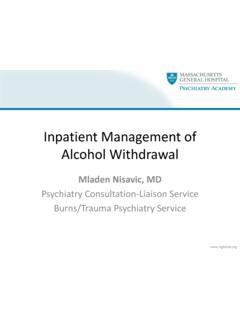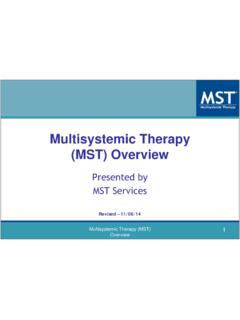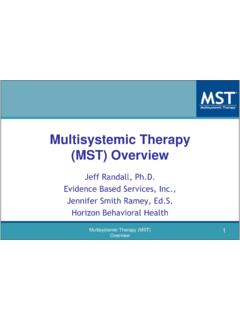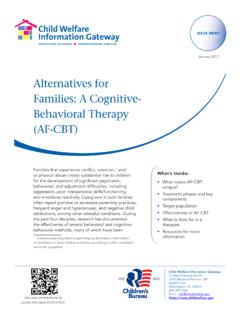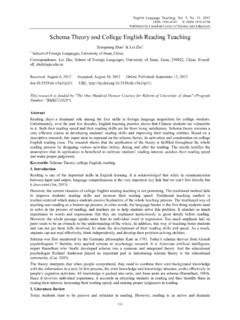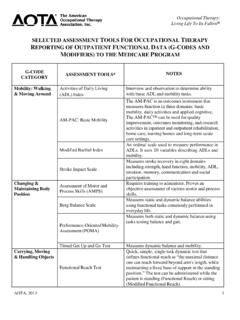Transcription of Cognitive Behavioral Therapy (CBT) for Substance Use Disorder
1 Behavioral Therapy (CBT) for Substance Use DisorderJohn F. Kelly, Neither I nor my spouse/partner has a relevant financial relationship with a commercial interest to is CBT and its assumptions?What are the clinical strategies involved in CBT? How effective is CBT as an intervention for SUD?How does it work? Some Behavioral Therapy (CBT) is CBT and its assumptions?What are the clinical strategies involved in CBT? _____How effective is CBT as an intervention for SUD?How does it work?Some Behavioral Therapy (CBT)
2 Quitting smoking is easy, I ve done it dozens of times Mark Model9 ThoughtsFeelingsBehaviorsTheory Key process mechanisms Substance use Recovery Social Control Lack of strong bonds with family, friends, work, religion, other aspects traditional society Goal-direction, structure and monitoring, shaping behavior to adaptive social bonds Social Learning Modeling and observation and imitation of Substance use, social reinforcement for and expectations of positive consequences from use; positive norms for use Social network composed of individuals who espouse abstinence, reinforce negative expectations about effects of substances, provide models of effective sober living Stress and coping life stressors ( , social/work/financial problems, phys/sex abuse) lead to Substance use especially those lacking coping and avoid problems.
3 Substance use form of avoidance coping, self-medication Effective coping enhances self-confidence and self-esteem Behavioral economics Lack of alternative rewards provided by activities other than Substance use Effective access to alternative, competing, rewards through involvement in educational, work, religious, social/recreational pursuits Source: adapted from Moos, RH (2011) Processes the promote recovery from addictive psychosocial theories for Based on social- Cognitive learning theory Substance use functionally related to major life problems Coping deficits ( , life stress, Substance -related cues)
4 Maintain use/relapse Coping skills training addresses and overcomes skill deficits Enhance identification and coping with high-risk situations/cues Increase active adaptive Behavioral - Cognitive coping Enhance sobriety-based social support11 What is CBT for SUD? addresses two major types of learning that contribute to by Association Classical ConditioningLearning by Consequence Operant Conditioning Neutral stimuli become triggers for Substance use/cravings, through repeated associations between stimuli and drug (conditioning).
5 Externaltriggers: People, places, time of day, day of week, Internaltriggers:thoughts, emotions, pain/physiological changes Substance use is shaped by the consequences of use. Positive Reinforcement: if after using a Substance a person feels more comfortable in social situations or happier etc. Negative Reinforcement: if Substance use reduces anxiety, tension, stress, or depression; future use to reduce or terminate the unpleasant experience( , spraying a cat with waterFor jumping on the kitchen counter) Assumption.
6 Substance problems arise/continue due to deficits in sober coping is motivated to stop/reduce Substance use-needs to acquire skills to do to engage in active coping when encountering precipitants to Substance use contributes to is differentially effective in increasing active coping efforts when compared to alternative problems with coping are attributable to skills deficits, performance-based skill training techniquesare necessary to remediate deficitsAssumptions of is CBT and its assumptions?What are the clinical strategies involved in CBT?
7 How effective is CBT as an intervention for SUD?Does it work the way we think it does?Some Behavioral Therapy (CBT) Establish good therapeutic relationship Educate patients: model, Disorder , Therapy Assess illness objectively, set goals Use evidence to guide treatment decisions (collaborative empiricism) Structure treatment sessions with agenda Limit treatment length Issue and review homework to generalize learning16 Common Components of social- Cognitive learning framework Substance use becomes predominant coping response to triggers ( functional analysis )
8 , environmental, Cognitive , Skills , problem solving, environmental restructuring, social-interpersonal skills, Cognitive restructuring, coping with craving/urges, control developing support systems Change positive expectancies about effects of use, access alternative reinforcers Develop social systems to support and reinforce relapse risk (Abstinence Violation Effect)Major Goals of InducedStress InducedSubstance InducedSocialPsychNeuro-biologyCBTC ommon Precursors to Relapse and How CBT might helpKelly JF, Yeterian, JD, (2013).
9 In McCradyand Epstein. Comprehensive Textbook on Substance Abuse. ConsequencesNegative ConsequencesModel for CBT Treatment (behavior chain): Functional analysis of Substance use Chain Modifying WorksheetExample11:45 PM and in bed and not asleep I need alcohol to get to sleep"AnxietyDrink alcoholDrowsySleepWake up early;jittery; worriedTriggerThoughtsFeelingsBehaviorPo sitive ConsequencesNegative is CBT and its assumptions?What are the clinical strategies involved in CBT? How effective is CBT as an intervention for SUD?
10 Does it work the way we think it does?Some Behavioral Therapy (CBT) Meta-analysisof 53 controlled trials (1982-2006) of CBT for adults with alcohol-or drug-use disorders. Findings demonstrate utility ofCBTacross a large and diverse sample of studies and under rigorous conditions for establishing Treatment Effect Small but statistically significant treatment effect (g = , p < .005) Effects diminished over time:6-to 9-months (g = , p < .005)12 months (g = , p < .05)Subgroup Moderators Across substances, strongest among marijuana users(g = , p <.)
